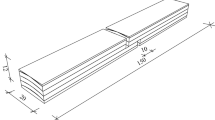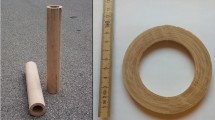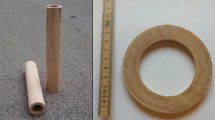Abstract
Innovative circular, hollow, laminated veneer lumber (LVL) beech sections for use as temporary geotechnical soil reinforcement members are currently being developed. Appropriate surface gluing quality between the veneers is fundamental to this subsoil application of the permanently cement-embedded, engineered timber product. The circular cross-section geometry and the permanently high-alkaline environment of the structural member is not covered by presently standardized testing and conditioning methods for examining LVL surface bond line quality. The sample conditioning and tensile shear test method compliant with EN 302-1 (Adhesives for load-bearing timber structures—test methods—part 1: determination of longitudinal tensile shear strength, European Committee for Standardization, Brussels, 2013) was modified to determine bonding parameters for circular, hollow LVL sections. Bond line curvature, groove cutting depth and sample geometry were found to greatly influence stress distribution, percentage of wood failure and tensile shear strength. Short-term alkaline treatment of test samples did not significantly influence the bonding performance, wood failure percentage, tensile shear strength and fracture patterns. To improve tensile shear strength, adhesives with different material rigidities were used and compared. An orthotropic, elastic numerical analysis revealed a greater influence of adherent elasticity than adhesive elasticity on the stress distribution within the bond line. With regard to determining the bond line integrity of curved veneer poles, a sample geometry compliant with EN 302-1 (2013) was developed and numerically evaluated.















Similar content being viewed by others
References
Altunok M, Percin O, Wetzig M, Niemz P (2013) Eigenschaften von Schichtholz (LVL) aus wärmebehandelten Furnieren verschiedener Holzarten (Properties of laminated veneer lumber from heat-treated veneers of various wood species). Holztechnologie 54(4):5–10
Beck C, Taranczsweski R (2013) Einrichtung zur Herstellung eines aus mehreren Lagen von Blättern aus Holz als Furniere bestehenden Rohres und damit hergestelltes Rohr (Equipment for manufacturing a tube consisting of several layers of wood as veneers and the manufactured tube). Patent application DE 10 2013 208 166 A1; Applicant: LignoTUBE technologies GmbH & Co. KG, 01237 Dresden
Brandmair A, Wetzig M, Aigner N, Haß P, Clauß S, Niemz P (2010) Verfahrenstechnische Optimierung von PUR-basierten Klebstoffen zur Verklebung von Laubholz und Materialkombinationen (Process-related optimisation of PUR based adhesives for hardwood bonding): ETHZ/IfBHP Nr. 55. Forest & Timber project No. 2008.09. Swiss Federal Institute of Technology, Institute for Building Materials, Zürich
Brockmann W, Geiss PL, Klingen J, Schröder B (2012) Klebtechnik; Klebstoffe, Anwendungen und Verfahren (Adhesive technology; adhesives, applications and processes). Wiley-VCH Verlag GmbH & Co. KGaA, Somerset
DIN 53255 (2017) Testing of wood adhesives and glued wood joints—mechanical delamination tests by grooving and chopping. German Institute for Standardization, Berlin
EN 13986 (2015) Wood-based panels for use in construction—characteristics, evaluation of conformity and marking. European Committee for Standardization, Brussels
EN 14080 (2013) Timber structures—glued laminated timber and glued solid timber—requirements. European Committee for Standardization, Brussels
EN 14279 (2009) Laminated veneer lumber (LVL)—definitions, classification and specifications. European Committee for Standardization, Brussels
EN 14374 (2004) Timber structures—structural laminated veneer lumber—requirements. European Committee for Standardization, Brussels
EN 14490 (2010) Execution of special geotechnical works—soil nailing. European Committee for Standardization, Brussels
EN 15425 (2017) Adhesives—one component polyurethane (PUR) for load-bearing timber structures—classification and performance requirements. European Committee for Standardization, Brussels
EN 16351 (2015) Timber structures—cross laminated timber—requirements. European Committee for Standardization, Brussels
EN 302-1 (2013) Adhesives for load-bearing timber structures—test methods—part 1: determination of longitudinal tensile shear strength. European Committee for Standardization, Brussels
EN 314-1 (2004) Plywood—bonding quality—part 1: test methods. European Committee for Standardization, Brussels
EN 314-2 (1993) Plywood; bonding quality; part 2: requirements. European Committee for Standardization, Brussels
EN 322 (1993) Wood-based panels—determination of moisture content. European Committee for Standardization, Brussels
EN 635–2 (1995) Plywood—classification by surface appearance—part 2: hardwood. European Committee for Standardization, Brussels
Frihart CR (2005) Adhesive bonding and performance testing of bonded wood products. J ASTM Int 2(7):1–12. https://doi.org/10.1520/JAI12952
Frihart CR (2009) Adhesive groups and how they relate to the durability of bonded wood. J Adhes Sci Technol 23:601–617
Gilbert BP, Underhill ID, Bailleres H, El Hanandeh A, McGavin RL (2014) Veneer based composite hollow utility poles manufactured from hardwood plantation thinned trees. Constr Build Mater 66:458–466
Grabner M, Wolf A, Schwabl E, Schickhofer G (2016) Methods of forming veneer structures. In: Eberhardsteiner J, Winter W, Fadai A, Pöll M (eds) WCTE 2016: proceedings of the world conference on timber engineering. Vienna University of Technology, Vienna
Habenicht G (2009) Adhesive bonding: fundamentals, technologies, applications, 6th edn. VDI-book, Springer, Berlin
Hara Y, Kawai S, Sasaki H (1994) Manufacture and mechanical properties of cylindrical laminated veneer lumber. Wood Res 81:28–30
Hashim R, Sarmin SN, Sulaiman O, Yusof LHM (2011) Effects of cold setting adhesives on properties of laminated veneer lumber from oil palm trunks in comparison with rubberwood. Eur J Wood Prod 69:53–61
Hata T, Umemura K, Yamauchi H, Nakayama A, Kawai S, Sasaki H (2001) Design and pilot production of a “spiral-winder” for the manufacture of cylindrical laminated veneer lumber. J Wood Sci 47:115–123
Heebink BG (1946) Fluid-pressure molding of plywood. Report, no. R1624. United States Department of Agriculture, Forest Service, Forest Products Laboratory, Madison, Wisconsin
Hering S (2011) Charakterisierung und Modellierung der Materialeigenschaften von Rotbuchenholz zur Simulation von Holzverklebungen (Characterisation and modelling of the material properties of copper beech for simulating wood adhesion). Dissertation, Eidgenössische Technische Hochschule Zürich
Hirschmüller S, Marte R, Pravida J (2016) Laminated veneer lumber poles for temporary soil nailing-Investigation of material properties. In: Eberhardsteiner J, Winter W, Fadai A, Pöll M (eds) WCTE 2016: proceedings of the world conference on timber engineering. Vienna University of Technology, Vienna
Horioka K, Gamoh M (1973) The mechanism and durability of adhesion in wood-glue bonds. In: IUFRO. Devision 5 Forest Products (ed) IUFRO-5 meeting: proceedings. IUFRO, pp 508–527
Kläusler O, Hass P, Amen C, Schlegel S, Niemz P (2014) Improvement of tensile shear strength and wood failure percentage of 1C PUR bonded wooden joints at wet stage by means of DMF priming. Eur J Wood Prod 72:343–354
Klein B (2009) Leichtbau—Konstruktion; Berechnungsgrundlagen und Gestaltung (Lightweight construction—calculation basis and design), 8th revised and extended edition. Vieweg + Teubner Verlag, Wiesbaden
Kollmann F (1951) Technologie des Holzes und der Holzwerkstoffe (Technology of wood and wood-based materials): 1. Bd.: Anatomie und Pathologie, Chemie, Physik, Elastizität und Festigkeit (Volume 1: Anatomy and pathology, chemistry, physics, elasticity and strength), 2nd revised and extended edition. Technology of wood and wood-based materials/Franz Kollmann. Springer Berlin Heidelberg
Kollmann F (1955) Technologie des Holzes und der Holzwerkstoffe (Technology of wood and wood-based materials): 2. Bd.: Holzschutz, Oberflächenbehandlung, Trocknung und Dämpfen, Veredelung, Holzwerkstoffe, Spanabhebende und Spanlose Holzbearbeitung Holzverbindungen (Volume 2: wood protection, surface treatment, drying and steaming), 2nd revised and extended edition. Technology of wood and wood-based materials/Franz Kollmann. Springer Berlin Heidelberg
Konnerth J, Gindl W, Müller U (2007) Elastic properties of adhesive polymers. I. Polymer films by means of electronic speckle pattern interferometry. J Appl Polym Sci 103(6):3936–3939
Krackler V, Keunecke D, Niemz P (2010) Verarbeitung und Verwendungsmöglichkeiten von Laubholz und Laubholzresten (Processing and application possibilities of hardwood and hardwood waste). IfB project study. Swiss Federal Institute of Technology, Institute for Building Materials, Zurich
Kufner M (1978) Elastizitätsmodul und Zugfestigkeit von Holz verschiedener Rohdichte in Abhängigkeit vom Feuchtigkeitsgehalt (Elasticity module and tensile strength of wood of various raw densities, depending on moisture content). Holz Roh- Werkst 36(11):435–439
Künniger T (2007) Automatische Bestimmung des prozentualen Faserbruchanteils bei der industriellen Klebfestigkeitsprüfung (Automatic determination of the wood failure percentage in industrial bond strength testing): final report. FFWH project ID 2006.05. Swiss Federal Laboratories for Materials Science and Technology, Dübendorf
Ozyhar T, Hering S, Sanabria SJ, Niemz P (2013) Determining moisture-dependent elastic characteristics of beech wood by means of ultrasonic waves. Wood Sci Technol 47:329–341
Paulitsch M (1986) Methoden der Spanplattenuntersuchung: Grundlagen, Ausführungen, Anwendungen (Methods of investigating chipboard panels: fundamentals, design, applications). Springer, Berlin
prEN 14374 (2016) Timber structures—laminated veneer lumber (LVL)—requirements. European Committee for Standardization, Brussels
Rug W, Lißner A (2011) Untersuchungen zur Festigkeit und Tragfähigkeit von Holz unter dem Einfluss chemisch-aggressiver Medien (Investigations on the strength and load-bearing capacity of wood under the influence of chemically aggressive media). Bautechnik 88:177–188
Sasaki H, Kawai S (1994) Recent research and development work on wood composites in Japan. Wood Sci Technol 28(4):241–248
Schmidt M (2014) Die Verklebung von Buchenholz für tragende Holzbauteile unter besonderer Berücksichtigung der Farbverkernung (Bonding beech wood for load-bearing timber structures with particular consideration of coloured cores). Dissertation, Technische Universität München
Shukla SR, Kamdem DP (2009) Properties of laboratory made yellow poplar (Liriodendron tulipifera) laminated veneer lumber: effect of the adhesives. Eur J Wood Prod 67:397–405
Srinivasan N, Jayaraman K, Bhattacharyya D (2008) Profile production in multi-veneer sheets by continuous roll forming. Holzforschung 62:453–460
Stundl K (1955) Effects of phenolic sewages on receiving water and groundwater. Pathobiology 18:1012–1017
Tamburini U (1970) Alkaline degradation of wood: effects on Young’s modulus. Wood Sci Technol 4:284–291
Wittkowsky C (1896) Wooden vessel consisting of veneers. Patent application US 565655A; Applicant: Carl Wittkowsky, Berlin, Germany
Z-9.1-837 (2013) Brettschichtholz aus Buchen-Furnierschichtholz (Laminated timber made of beech laminated veneer lumber). German Institute for Structural Engineering, Berlin
Z-9.1-842 (2015) Laminated veneer lumber “STEICOLVL R”, “STEICOLVL RS”, STEICOLVL X”. German Institute for Structural Engineering
Acknowledgements
The authors would like to thank Mr. Alexander Englberger for his great efforts carrying out the tests and Dr. Christian Lehringer (Purbond AG) and Mr. Sebastian Meyer (Türmerleim) for providing adhesive and insights. The research was supported by the German Federal Ministry of Education and Research.
Funding
Funding was provided by Bundesministerium für Bildung und Forschung (13FH022IX4).
Author information
Authors and Affiliations
Corresponding author
Rights and permissions
About this article
Cite this article
Hirschmüller, S., Pravida, J., Marte, R. et al. Adhesive properties of laminated veneer lumber poles for use in temporary soil nailing: development and evaluation of a test method for curved structures in a high-alkaline environment. Wood Sci Technol 52, 1061–1092 (2018). https://doi.org/10.1007/s00226-018-0997-y
Received:
Published:
Issue Date:
DOI: https://doi.org/10.1007/s00226-018-0997-y




